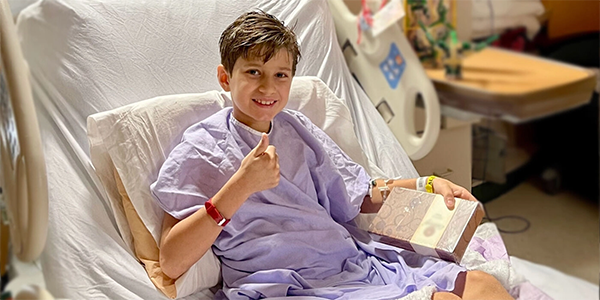Report: Pediatric Neurosurgery

Treating Chiari Malformation Across Disciplines, Across the Lifespan
Duke is building the first program for Chiari malformation in the southeastern U.S. under the leadership of Gerald A. Grant, MD, chair of the Department of Neurosurgery and a national expert in treating the condition.
The focus is on building a program that provides comprehensive and holistic care for both children and adults across the lifespan.
Interdisciplinary expertise is essential to manage the comprehensive care of
“That is the power of Duke,” said Grant. “That integration of adult and pediatrics is a rare thing.
It is often a congenital problem, but it can be acquired as well, and affects all ages.”
patients with Chiari malformation and syringomyelia. At Duke, the collaborative team includes neurosurgeons, neurologists who specialize in sleep issues, neuro-ophthalmologists, neuroradiologists, interventional radiologists who manage cerebrospinal fluid leaks, pain management specialists, and psychologists. Working as a team is essential to provide the individualized care and offer the best options to maximize quality of life, Grant says.
Advanced Epilepsy Care for Children and Young Adults
As a Level 4 Epilepsy Center, Duke offers the highest level of comprehensive care to children and adults with epilepsy, including leading-edge techniques like deep brain stimulation (DBS) and robot-assisted stereoelectroencephalography (SEEG).
Duke was the first center in North Carolina to use DBS for epilepsy (see related story). This procedure may be an option for people whose seizures come from many parts of the brain or in whom resection is not an option.
Stereo EEG or SEEG is a minimally invasive procedure that places thin electrode wires in precise locations to map the brain and identify seizure origins. A 3D reconstruction of the brain guides where the dozen or more electrodes will be placed.
“Because it is minimally invasive, placing depth electrodes this way is much better tolerated by patients than placing grid electrodes,” said Gerald Grant, MD, who treats young patients with epilepsy. Once the seizure origin is identified, the electrodes are removed, and patients recover quickly. That is a huge benefit.”

Gene Therapy Used to Treat Child with AADC Deficiency
A Duke team has successfully inserted a modified gene into a child’s brain to stimulate production of the missing neurotransmitter dopamine.
Pediatric neurosurgeon Matthew Vestal, MD, performed the procedure on a child with the autosomal recessive genetic disorder known as AADC deficiency. These children lack aromatic L-amino acid decarboxylase, a key enzyme needed for the synthesis of dopamine.
Without this neurotransmitter, these children require constant care and have a very short life expectancy.
The only therapies thus far have aimed at stimulating dopamine production, which provides little benefit.
Working as part of an international clinical trial, researchers used gene editing technology to insert the missing dopa decarboxylase gene responsible for AADC deficiency. The researchers inserted the genetic sequence into an adenovirus to take advantage of the virus’s ability to copy that gene into the patient’s DNA. The hope was that the child’s immune system would clear the virus but leave the inserted gene in the patient’s genome.
In November 2022, Vestal performed the MRI-guided stereotactic surgery over a 12-hour period. “This was the perfect population to prove the idea that if you are missing a gene, we can do one-time surgery to insert the gene back into your genome in the spot where you need it in the brain,” Vestal says.
Today, the patient is home and healthy – off medications and able to sit up unassisted and move their limbs.
All Chapters
Home / Brain Tumor / Epilepsy / Cerebrovascular & Skull Base / Pediatric / Chronic Pain / Trauma / Movement Disorders / Brain & Spine Metastasis / Spine / Global / Residency / Top Papers
